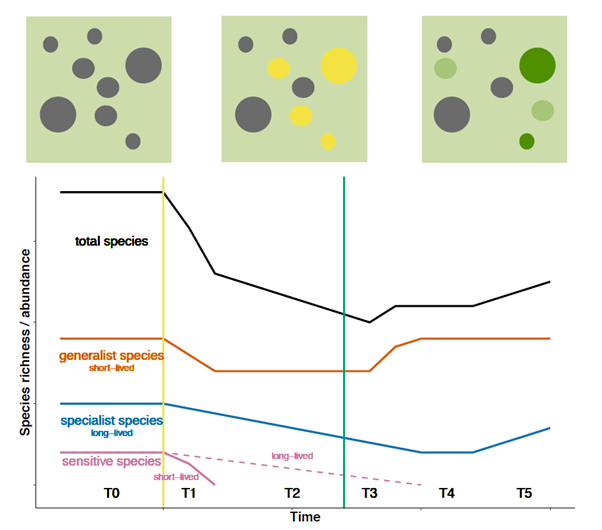Global biodiversity targets are repeatedly not met despite increasing conservation efforts. While in some cases this is due to inappropriate interventions or external pressures, in other cases, this is due to time lags in species’ responses to conservation efforts. Ecological time lags occur when there is a change to an ecosystem and species’ do not respond immediately. Extinction debt occurs following habitat destruction or degradation, and has been the focus of many theoretical and empirical studies. The converse of this is ‘colonisation credit’ – where species’ do not respond immediately to restoration efforts.
While there is an understanding that colonisation credit is a pervasive phenomena following habitat creation and restoration, there has been a failure to translate this ecological process into policy targets. Perhaps, because the empirical evidence for such lags is incomplete. These time lags suggest that when setting conservation targets, we also need to be setting milestones to ensure progress is on track.
The aim of this project is to provide an empirical basis for ecological time lags across species, scales and ecosystems. Building on theoretical and modelling work led by PI Graham and Co-I Watts, the project will aim to quantify ecological time lags and to test hypotheses generated by the theoretical work. We will aim to quantify the variation in the lag between restoration and meeting conservation targets, depending on (a) ecosystem type (forest or grassland), (b) species life history traits, and (c) landscape composition and configuration. The work will occur across three scales: a global synthesis will allow us to identify regions which show habitat gains and to unpick how these gains translate into changing trends for a range of species; at the national (UK) scale, we will dig deeper into these trends to understand how long restoration efforts take to yield biodiversity benefits across different taxa; at site scale, we will further develop our understanding of these lags and how they vary between species.
Figure 1: Hypothesised time lags following habitat destruction (first line, yellow patches), and then habitat creation (second line, green patches) for different species types.

This project is a CENTA Flagship Project.
This project is suitable for CASE funding
Each host has a slightly different application process.
Find out how to apply for this studentship.
All applications must include the CENTA application form.
Choose your application route
DRs will be awarded CENTA Training Credits (CTCs) for participation in CENTA-provided and ‘free choice’ external training. One CTC can be earned per 3 hours training, and DRs must accrue 100 CTCs across the three and a half years of their PhD.
You will receive training in cutting edge ecological modelling and remote sensing techniques. You will also benefit from the range of applied and theoretical ecology expertise of the supervisory team. The fieldwork component of the project will allow you to develop specific ecological survey techniques. Additionally, you will be part of the growing Ecology & Biogeography group at the University of Birmingham, which has a number of researchers across all career stages in the general field of ecology. As part of the Land Use and Ecosystem Services group at forest research you will be able to attend remote lab meetings and further extend your network.
The PhD project will work with CASE partner Birmingham and Black Country Wildlife Trust and EcoRecord who led the meadow creation scheme and hold the data. They will be able to advise on the field survey and will benefit from data gathered for this project.
The PhD candidate will also work closely with Kevin Watts at Forest Research. Kevin has a wealth of expertise in landscape ecology – both theoretical and applied – and has driven the colonisation credit research this project is building on.
The PhD candidate will also work with National Trust sites which are undertaking post-agricultural rewilding.
Y1: Project development and general training (i.e. statistics, project management, data synthesis). Planning of field study, with first data collection in the summer of this year. Begin bringing together the datasets for use in the project (chronosequence, bioTime, land-cover).
Y2: Paper writing, analysis of initial data, ongoing fieldwork, conference attendance
Y3: Data analysis, paper- and thesis-writing, and conference attendance.
Journal:
Dornelas, M., et. al, 2018. BioTIME: A database of biodiversity time series for the Anthropocene. Global Ecol Biogeogr 27, 760–786. https://doi.org/10.1111/geb.12729
Hughes, S., Kunin, W., Ziv, G., & Watts, K. (2023). Spatial targeting of woodland creation can reduce the colonisation credit of woodland plants. Ecological Solutions and Evidence, 4, e12263. https://doi.org/10.1002/2688-8319.12263
Jackson, S.T., Sax, D.F., 2010. Balancing biodiversity in a changing environment: extinction debt, immigration credit and species turnover. Trends in Ecology & Evolution 25, 153–160. https://doi.org/10.1016/j.tree.2009.10.001
Watts, K., Whytock, R.C., Park, K.J. et al. Ecological time lags and the journey towards conservation success. Nat Ecol Evol 4, 304–311 (2020). https://doi.org/10.1038/s41559-019-1087-8
For any enquiries related to this project please contact Laura Graham, [email protected]
To apply to this project:
Applications must be submitted by 23:59 GMT on Wednesday 7th January 2026.